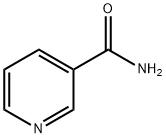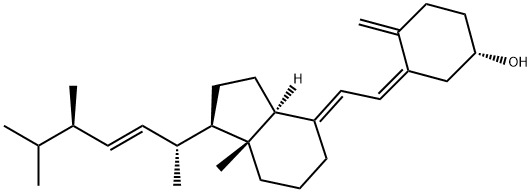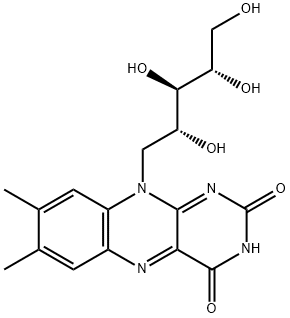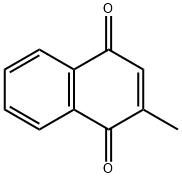Vitamin A
Synonym(s):Vitamin A;Vitamin A alcohol;Vitamin A alcohol solution;Vitamin A1;3,7-Dimethyl-9-(2,6,6-trimethyl-1-cyclohexenyl)-2,4,6,8-nonatetraen-1-ol
- CAS NO.:68-26-8
- Empirical Formula: C20H30O
- Molecular Weight: 286.45
- MDL number: MFCD00001552
- EINECS: 200-683-7
- SAFETY DATA SHEET (SDS)
- Update Date: 2025-03-07 18:45:43

What is Vitamin A?
Absorption
Readily absorbed from the normal gastrointestinal tract
Toxicity
Acute toxicity to vitamin A can occur when adults or children ingest >100x or >20x the RDA, respectively, over a period of hours or a few days. The RDA for vitamin A differs depending on age and sex and can range from 300 - 900 μg retinol activity equivalents (RAE) per day. Symptoms of acute systemic toxicity generally include mucocutaneous involvement (e.g. xerosis, cheilitis, skin peeling) and may involve mental status changes. Children are typically more susceptible to acute vitamin A toxicity - daily intakes of as little as 1500 IU/kg have been observed to result in toxicity.
Chronic vitamin A toxicity can develop following the long-term ingestion of high vitamin A doses. While there is a wide variation in the lowest toxic vitamin A dose, the ingestion of >25 000 IU daily for 6 years or 100,000 IU daily for 6 months is considered to be toxic. Chronic vitamin A toxicity can affect many organ systems and can lead to the development of osteoporosis and CNS effects (e.g. headaches).
Description
Human vitamin A is derived from the natural food. Natural vitamin A exists in dif ferent forms. In animal tissues, vitamin A is present in the form of retinoids.
However, in plants, the form of vitamin A called carotenoids is contained in the
green, orange, and yellow plant tissue. Vitamin A compounds such as retinol, reti nal, carotene, and so on from these foods can be converted to vitamin A in the
human body. Therefore, food is the main source of vitamin A.
As early as 1000 years ago, the Qian Jin Yao Fang written by Sun Simiao in Tang
Dynasty recorded that animal liver can cure night blindness. This is the early
recognition in vitamin A supplementation. The traditional Chinese medicine books
also recorded that nourishing the liver can improve eyesight. Researches on the
therapy of vitamin A deficient-diseases are mainly related to nourishing the liver
and kidney, supplementing essence and blood, and activating qi
Description
Vitamin A, or retinol, is produced from carotenoids in the livers of animals. It is also broadly defined as a series of compounds that have structures similar to retinol. It is essential for growth and development, and for strong vision. Retinoic acid is a metabolite of vitamin A that mediates the vitamin’s functions.
Recently, H. Veiga-Fernandes and co-workers at the Institute of Molecular Medicine (Lisbon) discovered that vitamin A is not only necessary for animals’ health, but?it also may be essential for setting up the immune system before birth, when fetuses are in utero. They found that pregnant mice with vitamin A–poor diets produce babies with small lymph nodes and consequently weak immune systems. Retinoic acid produced from the mother’s vitamin A activates a gene that produces a hormone receptor that mediates the growth of lymphoid cells.
Chemical properties
Yellow-Orange Powder
Physical properties
Vitamin A1 (VA1), Molecular formula, C20H30O; MW, 286.45; CAS, 68-26-8.
Melting point: 62–64 °C. Boiling point: 137–138 °C
VA2, Molecular formula, C20H28O; MW, 284.44; Melting point: 17–19 °C.
Originator
Acon ,Endo
History
The vitamin research is the great achievement in the development of life sciences,
while human beings only took half a century to discover and understand vitamins.
However, everything is still very difficult for scientists in the early stage of vitamin
discovery. From 1913 to 1915, Elmer McCollum and Marguerite Davis indicated
that the growth rate was maintained by at least two different kinds of growth factors:
one can be separated from eggs or butter, and the other one which multiple neuritis of chicks and pigeons can be extracted by water; thus they were
named fat-soluble vitamin A and water-soluble vitamin B.prevented
In 1919, the researchers demonstrated that fat-soluble vitamin A not only sup ported the rate of growth but also prevented eye dryness and night blindness in the
process of property study. In 1920, Dr. J.C. Drummond named this active lipid as
vitamin A. It exists in cod liver oil and prevents the occurrence of eye dryness and
night blindness.
The Uses of Vitamin A
mucolytic
The Uses of Vitamin A
vitamin A (Retinol) is the fat-soluble vitamin a which is required for new cell growth and prevention of night blindness. There is no appreciable loss by heating or freezing, and it is stable in the absence of air. Sources include liver, fortified margarine, egg, and milk. Vitamin A palmitate can be found in frozen egg substitute.
The Uses of Vitamin A
Occurs preformed only in animals; metabolized from carotenoids, such β-carotene, in the intestinal mucosa. Dietary sources include liver, milk, butter, cheese, eggs and fish liver oils or as carotenoi s from fruits and vegetables. Stored primarily in the liver in esterified form; transported in the blood by retinol binding protein (RBP). Nutritional factor.
The Uses of Vitamin A
Atracurium Besilate intermediate
The Uses of Vitamin A
retinol is a retinoid considered to be a skin revitalizer. It is reported to enhance skin radiance and treat conditions associated with chronological aging, such as wrinkles and fine lines, as well as dermatological disorders, including acne, follicular and lesion papules, actinic keratosis, oily skin, and rosacea. According to clinical dermatologists, retinol is one of the few substances with a demonstrated ability to reduce and prevent fine lines and wrinkles. It is able to alter the behavior of aged cells so they act in a more youthful manner. It is considered necessary for normal epidermal cell growth and differentiation and stimulates the production of new blood vessels in the skin, improving skin tone. In addition, retinol has anti-oxidant capacities and protects dermal fibers by counteracting the increased activity of enzymes that degrade collagen and elastin when the skin is exposed to uV rays. Retinol can be drying to the skin when used for a prolonged period of time or in concentrations that are too high. A weaker retinoid than retinoic acid, retinol converts to retinoic acid once on the skin. When compared to retinoic acid, retinol has an increased penetration potential and is less irritating, making it an effective ingredient for anti-aging products. The anti-aging benefits of topically treating skin with retinol are based on its penetration ability, which allows it to reach the sites in the skin requiring treatment. When used on sensitive skin for a prolonged period of time or in concentrations that are too high, retinol can cause dermatitis.
The Uses of Vitamin A
Vitamin A1 (retinal) is produced from (3-carotene, which can be obtained by fermentation of corn, soybean meal, kerosene, thiamin, and oc-ionone. The dry-mass after fermentation contains 120 to 150 g product/kg.
What are the applications of Application
Vitamin A is a group of unsaturated nutritional organic compounds, including retinol, retinal, retinoic acid, provitamin A carotenoids, and beta-carotene.
Indications
For the treatment of vitamin A deficiency.
Background
Retinol and derivatives of retinol that play an essential role in metabolic functioning of the retina, the growth of and differentiation of epithelial tissue, the growth of bone, reproduction, and the immune response. Dietary vitamin A is derived from a variety of carotenoids found in plants. It is enriched in the liver, egg yolks, and the fat component of dairy products.
Definition
ChEBI: A retinol in which all four exocyclic double bonds have E- (trans-) geometry.
Indications
Vitamin A, or retinol, is essential for the proper maintenance of the functional and structural integrity of epithelial cells, and it plays a major role in epithelial differentiation. Bone development and growth in children have also been linked to adequate vitamin A intake. Vitamin A, when reduced to the aldehyde 11-cis-retinal, combines with opsin to produce the visual pigment rhodopsin. This pigment is present in the rods of the retina and is partly responsible for the process of dark adaptation.
Manufacturing Process
Manufacturing process for Vitamin A includes these steps as follows: Step A: Synthesis of Preparation of ethyl ether of ethynyl-β-ionol;Step B: Coupling Reaction; Step C:Semi-Hydrogenation of Coupling Product;Step D:Hydrolysis of Semi-Hydrogenated Coupling Product. Separation of Vitamin A from the product obtained was achieved by acetylating the total reaction product using pyridine-acetic anhydride at room
temperature and chromatographing on alumina neutralized with acetic acid. A
fairly clean separation was achieved. The Vitamin A acetate fraction was
sufficiently pure to become crystallized from pentane at -15°C when seeded
with a pure Vitamin A acetate crystal.
When the Vitamin A acetate was converted to the alcohol form of Vitamin A,
the final product showed the characteristic infrared and ultraviolet absorption
curves for Vitamin A. Similar results were obtained using as co-solvents (with
the liquid ammonia) ethylene diamine and ether; pentane; tetrahydrofuran;
diethylamine and hexamethylphosphoramide.
brand name
Avibon.
Therapeutic Function
Vitamin
World Health Organization (WHO)
Vitamin A, a fat-soluble vitamin, is used in the treatment and prevention of vitamin A deficiency resulting from inadequate dietary intake. It has been demonstrated to be teratogenic at high doses (more than 25,000 IU per day). Daily dosages of less than 10000 IU seem to be free of this risk. Retinol (vitamin A) is listed in the WHO Model List of Essential Drugs.
Synthesis Reference(s)
Tetrahedron, 51, p. 2435, 1995 DOI: 10.1016/0040-4020(94)01108-C
General Description
Retinal, retinol and retinoic acid are the aldehyde, alcohol and acid forms of vitamin A. The retinoids exist as many geometric isomers due to the unsaturated bonds in the aliphatic chain. Retinol is biologically active in a wide range of processes.
Biochem/physiol Actions
Retinol and its derivatives exhibit anti-aging properties. Retinol is used for treating wrinkles and signs of aging. However, due to its photo instability and skin irritation potency, it is hardly used in cosmetic formulations. Retinol is also used as a therapeutic for dermatoses. Its deficiency leads to xerosis and follicular hyperkeratosis.
Pharmacokinetics
Vitamin A is effective for the treatment of Vitamin A deficiency. Vitamin A refers to a group of fat-soluble substances that are structurally related to and possess the biological activity of the parent substance of the group called all-trans retinol or retinol. Vitamin A plays vital roles in vision, epithelial differentiation, growth, reproduction, pattern formation during embryogenesis, bone development, hematopoiesis and brain development. It is also important for the maintenance of the proper functioning of the immune system.
Pharmacology
Intake of vitamin A precursors, such as carotenoids, retinyl esters, retinol, and reti nal, can maintain the epithelial cell differentiation, normal proliferation, and visual
function. All of these substances can be metabolized into retinol, retinal, and reti noic acid. But unlike retinol and retinal, retinoic acid cannot be reduced to retinol
and retinal. Intake of retinoic acid can only maintain the systemic function of vita min A.
Visual and vitamin A. 11-cis-retinal plays an important role as a photographic
group of retinal cones and visual pigments in rod cells. 11-cis-retinal would be
transformed into all-trans-retinal form under the light induction. The dissociation of
all-trans retinal and opsin was coupled with the nerve stimulation of the brain’s
visual center. By a series of biochemical processes, nerve impulses format in the rod
cells at the end of synapse, and then the optic nerve conducts the nerve impulses
along. The visual process is a component renewable cycle, and all-trans-retinal can
be enzymatically modified to 11-cis form in dark conditions.
The systemic effects of vitamin A. Vitamin A not only significantly affects visual
function but also has a greater physiological impact than visual function. Vitamin A
deficiency destroys the visual cycle, leads to dark adaptation damage (night blind ness or nyctalopia), and destroys systemic function which is necessary to maintain
life (e.g., corneal injury, infection, and hypoplasia). Vitamin A deficiency can lead
to animal death.
Vitamin A functions in reproduction and embryonic development. Vitamin A
plays an important role in the reproductive process of sperm production and ovula tion, but its biochemical basis is unclear. Vitamin A plays a key role in the develop ment of embryos and organism and maintenance of tissue function. The main organs
affected by vitamin A deficiency are the heart, eye tissue, circulatory system, geni tourinary system, and respiratory system. Vitamin A is necessary for embryonic
development.
Vitamin A functions on immune function. The lymphoid organs, cell distribu tion, histology, lymphocytes, and other characteristics will change when the ani mals lack vitamin A. Vitamin A deficiency can lead to immune function decrease,
induce inflammation, and exacerbate inflammatory symptoms
Vitamin A functions in dermatology. Vitamin A plays an important role in main taining healthy skin. Vitamin A deficiency disrupts human keratin cell terminal dif ferentiation and makes the skin rough, dry, scaly, and clogged
It is reported that vitamin A can degrade malignant melanoma and T-cell lymphoma
epidermal transfer, reduce the oil secretion of the common acne and the number of
bacteria in the epidermis and capillaries, and inhibit immune response of monocytes
and neutrophils.
Vitamin A plays an important role as an important function material in the body
system, such as hematopoietic function, bone development, tumor prevention, and
so on. Therefore, supplement of vitamin A is necessary for health requirements
Clinical Use
Principal dietary sources of vitamin A are milk fat
(cheese and butter) and eggs. Since it is stored in the
liver, inclusion of liver in the diet also provides vitamin
A. A plant pigment, carotene, is a precursor for vitamin
A and is present in highly pigmented vegetables, such as
carrots, rutabaga, and red cabbage.
An early sign of hypovitaminosis A is night blindness.
This condition is related to the role of vitamin A as
the prosthetic group of the visual pigment rhodopsin.
The night blindness may progress to xerophthalmia
(dryness and ulceration of the cornea) and blindness.
Other symptoms of vitamin A deficiency include cessation
of growth and skin changes due to hyperkeratosis.
Since vitamin A is a fat-soluble vitamin, any disease
that results in fat malabsorption and impaired liver storage
brings with it the risk of vitamin A deficiency; these
conditions include biliary tract disease, pancreatic disease,
sprue, and hepatic cirrhosis. One group at great
risk are children from low-income families, who are
likely to lack fresh vegetables (carotene) and dairy
products (vitamin A) in the diet.
Side Effects
Acute hypervitaminosis A results in drowsiness, headache, vomiting, papilledema, and a bulging fontanel in infants. The symptoms of chronic toxicity include scaly skin, hair loss, brittle nails, and hepatosplenomegaly. Anorexia, irritability, and swelling of the bones have been seen in children. Retardation of growth also may occur. Liver toxicity has been associated with excessive vitamin A intake. Vitamin A is teratogenic in large amounts, and supplements should not be given during a normal pregnancy. The IOM has reported the UL of vitamin A to be 3,000 μg/day.
Safety Profile
Moderately toxic by ingestion. Human teratogenic effects by ingestion: developmental abnormalities of the craniofacial area and urogenital system. An experimental teratogen. Experimental reproductive effects. Human mutation data reported. When heated to decomposition it emits acrid smoke and irritating fumes.
Metabolism
Hepatic. Retinol is conjugated with glucuronic acid; the B-glucuronide undergoes enterohepatic circulation and oxidation to retinol and retinoic acid. Retinoic acid undergoes decarboxylation and conjugation with glucuronic acid.
Purification Methods
Purify retinol by chromatography on columns of water-deactivated alumina and elute with 3-5% acetone in hexane. Separate the isomers by TLC plates on silica gel G, developed with pet ether (low boiling)/methyl heptanone (11:2). Store it in the dark, under N2, at 0o, or in Et2O, Me2CO or EtOAc. [See Gunghaly et al. Arch Biochem Biophys 38 75 1952, Beilstein 6 IV 4133.]
Toxicity evaluation
The exact mechanism leading to toxicity is not known. Both
acute and chronic toxicity may occur.
Acute and Short-Term Toxicity (or Exposure)
Human
Acute toxicity is uncommon in adults. However, vitamin A
ingestions of greater than 1 million IU in adults and greater
than 300 000 IU in children have resulted in the development
of increased intracranial pressure (symptoms described include
headache, dizziness, vomiting, visual changes, and bulging
fontanel in infants). Acute ingestions of greater than 12 000 IU
per kilogram are also considered toxic.
Chronic Toxicity (or Exposure)
Human
Toxicity is more frequently seen with chronic ingestion of
high doses of 30 000–50 000 IU per day. Vitamin A toxicity in
children develops following chronic ingestion of 410 times
the recommended daily allowance for weeks to months.
Malnutrition and individual tolerance may also be factors in
predisposition to toxicity. Signs and symptoms of toxicity
include vomiting, anorexia, agitation, fatigue, double vision,
headache, bone pain, alopecia, skin lesions, increased intracranial
pressure, and papilledema. Hepatic toxicity typically requires months or years of daily high doses of vitamin A.
There are no known cases of vitamin A toxicity associated with
beta-carotene ingestion.
Properties of Vitamin A
| Melting point: | 61-63 °C(lit.) |
| Boiling point: | 368.81°C (rough estimate) |
| Density | 0.9933 (rough estimate) |
| refractive index | 1.641 |
| Flash point: | -26 °C |
| storage temp. | -20°C |
| solubility | Chloroform (Slightly), Methanol (Slightly) |
| form | crystalline |
| pka | 14.09±0.10(Predicted) |
| color | yellow to orange |
| Water Solubility | Practically insoluble inwaterorglycerol; soluble in absolute alcohol,methanol,℃hloroform, ether, fats and oils. |
| Sensitive | Moisture & Light Sensitive |
| Merck | 13,10073 |
| BRN | 403040 |
| Stability: | Stable, but light and air sensitive. Incompatible with strong acids, strong oxidizing agents. |
| CAS DataBase Reference | 68-26-8(CAS DataBase Reference) |
| EPA Substance Registry System | Retinol (68-26-8) |
Safety information for Vitamin A
| Signal word | Danger |
| Pictogram(s) |
 Exclamation Mark Irritant GHS07  Health Hazard GHS08 |
| GHS Hazard Statements |
H317:Sensitisation, Skin H319:Serious eye damage/eye irritation H413:Hazardous to the aquatic environment, long-term hazard |
| Precautionary Statement Codes |
P201:Obtain special instructions before use. P273:Avoid release to the environment. P280:Wear protective gloves/protective clothing/eye protection/face protection. P302+P352:IF ON SKIN: wash with plenty of soap and water. P305+P351+P338:IF IN EYES: Rinse cautiously with water for several minutes. Remove contact lenses, if present and easy to do. Continuerinsing. P308+P313:IF exposed or concerned: Get medical advice/attention. |
Computed Descriptors for Vitamin A
Related products of tetrahydrofuran








You may like
-
 68-26-8 Vitamin A 98%View Details
68-26-8 Vitamin A 98%View Details
68-26-8 -
 68-26-8 / 11103-57-4 98%View Details
68-26-8 / 11103-57-4 98%View Details
68-26-8 / 11103-57-4 -
 Vitamin A 98%View Details
Vitamin A 98%View Details
68-26-8 / 11103-57-4 -
 Vitamin A 95.00% CAS 68-26-8View Details
Vitamin A 95.00% CAS 68-26-8View Details
68-26-8 -
 Retinol CAS 68-26-8View Details
Retinol CAS 68-26-8View Details
68-26-8 -
 Retinol CAS 68-26-8View Details
Retinol CAS 68-26-8View Details
68-26-8 -
 Retinol CAS 68-26-8View Details
Retinol CAS 68-26-8View Details
68-26-8 -
 37951-47-6 3'-Benzyloxy propiophenone, 98% 99%View Details
37951-47-6 3'-Benzyloxy propiophenone, 98% 99%View Details
37951-47-6